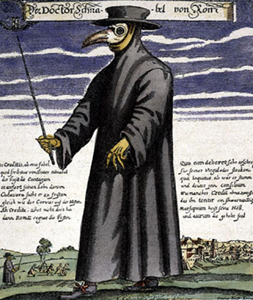An Oregon man has been hospitalized in Bend with a disease that appears to be caused by Y. pestis, aka the Black Death. He got it after trying to rescue a mouse from the mouth of a stray cat. People, just stay away from the things cats put in their mouths. Also, beware of mice, rats, and other rodents, including squirrels (esp. in northern CA, which has seen a rash of squirrel deaths caused by the plague). They carry fleas that can transmit the disease.
I wonder if the man's doctor had to wear protective gear, like this:
Friday, June 15, 2012
Black Death PSA: Stay Away from Vermin
Labels:
current events,
medieval,
medieval mash-up,
science,
wtf
Wednesday, June 6, 2012
What Is Dead May Never Die
 |
| Yes. |
"People believed the rod would pin the dead into their graves to prevent them from leaving at midnight and terrorising the living."
Regional customs for dealing with vampires vary. In Venice, those suspected of vampirism were buried with a brick between their teeth (this is confusing to me, as it suggests that vampirism could be detected before someone died).
 | |
| More yes. |
Musings on the Transit of Venus
The transit of Venus yesterday has me thinking about rare celestial phenomena and their meanings. It was incredibly cool to read about people viewing the transit and also to watch the NASA live webcam. I watched the transit from my sitting room in London, as the 100% cloud cover made it impossible to see. (The first transit to be recorded was by an Englishman, Jeremiah Horrocks, who saw it while he was actually in England. Talk about a lucky break, given the weather here.) That was my last chance, unless I live to see 2117 (doubtful).
All of the news coverage I saw referred to the importance of this predictable astronomical event in terms of helping astronomers ascertain more precise information about the Sun. One of the astronomers on the NASA feed talked about how the transit could end up causing disturbances in Earth's electromagnetic field, perhaps leading to patchy cell phone coverage (AT&T, you finally have a legit excuse!).
Medieval astronomers and scholars thought that celestial bodies emitted cosmic rays absorbed by Earth. These rays had measurable effects on earthly bodies, especially plants and minerals. Certain plants harvested while certain planets or stars were ascendant would have particular potency. Minerals, especially gemstones, would be imbued with particular powers by cosmic rays. William of Auvergne, a scholastic philosopher of the early thirteenth century explained the link between gemstones and celestial bodies:
…they [planets] might be collections of lights in parts of heaven itself, just as it appears among us in certain gems. For in fact I recollect when I saw an emerald, which in brilliance it appeared three shining stars. And this is true of the stone that is called heliotrope, because it is itself a green stone, growing brilliant red by means of a star… (De universo, 1.1.42).
And rare celestial phenomena were believed to portend important events on earth. Halley's Comet appeared over England in 1066, portending Harold's defeat at the hands of William the Bastard. Though now that I've experienced how difficult it is to see any celestial bodies over England, given the cloud cover, I'm beginning to wonder if the whole thing hasn't been completely made up.
All of the news coverage I saw referred to the importance of this predictable astronomical event in terms of helping astronomers ascertain more precise information about the Sun. One of the astronomers on the NASA feed talked about how the transit could end up causing disturbances in Earth's electromagnetic field, perhaps leading to patchy cell phone coverage (AT&T, you finally have a legit excuse!).
Medieval astronomers and scholars thought that celestial bodies emitted cosmic rays absorbed by Earth. These rays had measurable effects on earthly bodies, especially plants and minerals. Certain plants harvested while certain planets or stars were ascendant would have particular potency. Minerals, especially gemstones, would be imbued with particular powers by cosmic rays. William of Auvergne, a scholastic philosopher of the early thirteenth century explained the link between gemstones and celestial bodies:
…they [planets] might be collections of lights in parts of heaven itself, just as it appears among us in certain gems. For in fact I recollect when I saw an emerald, which in brilliance it appeared three shining stars. And this is true of the stone that is called heliotrope, because it is itself a green stone, growing brilliant red by means of a star… (De universo, 1.1.42).
And rare celestial phenomena were believed to portend important events on earth. Halley's Comet appeared over England in 1066, portending Harold's defeat at the hands of William the Bastard. Though now that I've experienced how difficult it is to see any celestial bodies over England, given the cloud cover, I'm beginning to wonder if the whole thing hasn't been completely made up.
 |
| Halley's Comet, in the Bayeux Tapestry. |
Subscribe to:
Posts (Atom)
